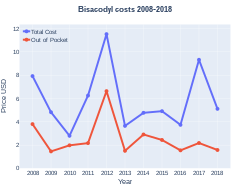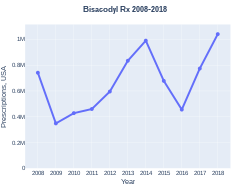Bisacodyl
 | |
 | |
| Names | |
|---|---|
| Trade names | Fleet, Dulcolax, Brooklax, others |
| |
| Clinical data | |
| Drug class | Stimulant laxative[1] |
| Main uses | Constipation, clear the bowels for colonoscopy[1][2] |
| Side effects | Abdominal cramps, nausea[1] |
| Pregnancy category |
|
| Routes of use | By mouth, rectal |
| Onset of action | 6 to 12 hr (by mouth), <1 hr (rectal)[1] |
| External links | |
| AHFS/Drugs.com | Monograph |
| MedlinePlus | a601027 |
| Legal | |
| Legal status |
|
| Pharmacokinetics | |
| Bioavailability | 15% |
| Metabolism | Liver (CYP450-mediated) |
| Elimination half-life | 16 Hours |
| Excretion | Primarily in the feces, systemically absorbed drug is excreted in the urine |
| Chemical and physical data | |
| Formula | C22H19NO4 |
| Molar mass | 361.397 g·mol−1 |
| 3D model (JSmol) | |
| |
| |
Bisacodyl is a medication use for constipation and to clear the bowels before colonoscopy.[1][2] It may be taken by mouth or used rectally.[1] Generally by mouth effects occur in 6 to 12 hours while rectally effects are within an hour.[1] Long term use appears to be safe.[3]
Common side effect include abdominal cramps and nausea.[1] Other side effects may include dehydration, electrolyte problems, and angioedema.[4] Use in pregnancy appears to be generally safe.[4] It is a type of stimulant laxative.[1] It is believed to work by altering water and electrolyte absorption and increasing the contraction of the large intestines.[1][3]
Bisacodyl was patented in 1952 and came into medical use in 1953.[5][6] It is on the World Health Organization's List of Essential Medicines as an alternative to senna.[7] It is avaliable as a generic medication, over the counter, and is inexpensive.[4][3] It is sold under a number of brand names including Dulcolax and Fleet.[1]
Medical use
Administration
When bisacodyl is administered orally, it is usually taken at bedtime.[4] Oral administration is known to produce no action for more than eight hours and then to work suddenly and relatively quickly. This is especially true if more than 10 mg is taken at one time. Normally, the dosage is 5 or 10 mg, but up to 30 mg can be taken for complete cleansing of the bowel before a procedure.
When administered rectally in suppository form, it is usually effective in 15 to 60 minutes. For optimal use, if used as a suppository, it is recommended that bisacodyl be given after breakfast to synchronize with the gastrocolic reflex.[3] Two suppositories can be inserted at once if a very strong, purgative, enema-like result is needed. A few hours after the initial evacuation, there can be a secondary action which will continue as long as there is unexpelled bisacodyl present in the rectum.
As a commercially prepared micro-enema, it is usually effective in 5 to 20 minutes.[8]
Mechanism of action
Bisacodyl works by stimulating enteric nerves to cause peristalsis, i.e., colonic contractions. It is also a contact laxative; it increases fluid and salt secretion. The action of bisacodyl on the small intestine is negligible; stimulant laxatives mainly promote evacuation of the colon.[8]
Society and culture
Cost
The cost in the United States is around $10 for a supply of 100 tablets of the 5 mg dose by mouth.[9] In 2021 in the UK, 100 tablets of the 5mg dose by mouth costs the NHS between £3.45 an £5.60.[4]
-
Bisacodyl costs (US)
-
Bisacodyl prescriptions (US)
Brand names
Bisacodyl brands include Dulcolax, Durolax, Fleet, Nourilax, Alophen, Correctol, Feen-A-Mint, Bisac-Evac and Carter's Little Pills.[1]
It is usually sold as 5 mg tablets, 10 mg suppositories, or 5 mg pediatric suppositories.[4] It is also available as a 1.25 US fluid ounces (37 ml) pre-packaged enema containing a 10 mg delivered dose of liquid bisacodyl.[8]
References
- ↑ 1.00 1.01 1.02 1.03 1.04 1.05 1.06 1.07 1.08 1.09 1.10 1.11 "Bisacodyl Monograph for Professionals". Drugs.com. Archived from the original on 13 February 2021. Retrieved 13 February 2021.
- ↑ 2.0 2.1 Wexner SD, Beck DE, Baron TH, Fanelli RD, Hyman N, Shen B, Wasco KE (June 2006). "A consensus document on bowel preparation before colonoscopy: prepared by a task force from the American Society of Colon and Rectal Surgeons (ASCRS), the American Society for Gastrointestinal Endoscopy (ASGE), and the Society of American Gastrointestinal and Endoscopic Surgeons (SAGES)". Gastrointestinal Endoscopy. 63 (7): 894–909. doi:10.1016/j.gie.2006.03.918. PMID 16733101.
- ↑ 3.0 3.1 3.2 3.3 Wald A (January 2016). "Constipation: Advances in Diagnosis and Treatment". JAMA (Review). 315 (2): 185–91. doi:10.1001/jama.2015.16994. PMID 26757467.
- ↑ 4.0 4.1 4.2 4.3 4.4 4.5 BNF (80 ed.). BMJ Group and the Pharmaceutical Press. September 2020 – March 2021. p. 65-66. ISBN 978-0-85711-369-6.
{{cite book}}: CS1 maint: date format (link) - ↑ Engel, Jürgen; Kleemann, Axel; Kutscher, Bernhard; Reichert, Dietmar (2009). Pharmaceutical Substances, 5th Edition, 2009: Syntheses, Patents and Applications of the most relevant APIs. Georg Thieme Verlag. p. 161. ISBN 978-3-13-179275-4. Archived from the original on 2021-08-28. Retrieved 2020-11-09.
- ↑ Capasso, Francesco; Gaginella, Timothy S. (2012). Laxatives: A Practical Guide. Springer Science & Business Media. p. PT65. ISBN 978-88-470-2227-0. Archived from the original on 2021-08-28. Retrieved 2020-11-09.
- ↑ World Health Organization (2023). The selection and use of essential medicines 2023: web annex A: World Health Organization model list of essential medicines: 23rd list (2023). Geneva: World Health Organization. hdl:10665/371090. WHO/MHP/HPS/EML/2023.02.
- ↑ 8.0 8.1 8.2 Engelhorn R, Seeger E, Zwaving JH (2000). "Laxatives". Ullmann's Encyclopedia of Industrial Chemistry. Weinheim: Wiley-VCH. doi:10.1002/14356007.a15_183. ISBN 3527306730.
- ↑ "Bisacodyl Prices, Coupons & Patient Assistance Programs". Drugs.com. Archived from the original on 13 February 2021. Retrieved 10 February 2021.
External links
- Bisacodyl Consumer Drug Information Archived 2016-11-17 at the Wayback Machine
| Identifiers: |
|---|
- Pages using duplicate arguments in template calls
- CS1 maint: date format
- Drugs with non-standard legal status
- Chemical articles with unknown parameter in Infobox drug
- Chemical articles without CAS registry number
- Articles without EBI source
- Chemical pages without ChemSpiderID
- Chemical pages without DrugBank identifier
- Articles without KEGG source
- Articles without UNII source
- Drugs missing an ATC code
- Drugboxes which contain changes to verified fields
- Drugboxes which contain changes to watched fields
- Webarchive template wayback links
- Articles with changed DrugBank identifier
- Acetate esters
- Laxatives
- Pyridines
- Bis(4-hydroxyphenyl)methanes
- RTT
- World Health Organization essential medicines (alternatives)

